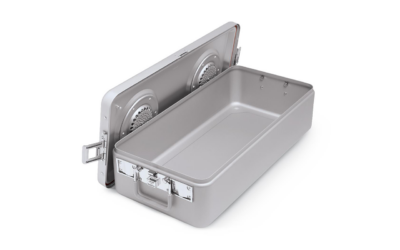The market for disinfection robots is expected to grow from $30 million in 2014 to $80 million by 2017, according to published reports. In recent years, hospitals and other health care facilities have turned to robots, or portable enhanced environmental disinfection systems, that feature ultraviolet-C (UV-C) light or hydrogen peroxide vapor (HPV) to complement infection control protocols already in place to battle multi-drug-resistant organisms.
The growth of the market can be attributed to the ongoing fight against hospital-acquired infections (HAIs). Many health care facilities are turning to “robots” to help combat Clostridium difficile (C. diff), methicillin-resistant Staphylococcus aureus (MRSA) and more as pathogens mutate to resist antibiotics and disinfectants.
According to the U.S. Centers for Disease Control and Prevention, a survey of acute care hospitals found 1 in 25 hospital patients has at least 1 HAI on any given day and that 75,000 deaths per year are due to HAIs. The thoroughness of terminal cleaning of patient rooms in acute care hospitals is one area of focus to reduce HAIs and improve patient care.
These robots help fight HAIs without additional labor costs. While disinfection robots remain fairly new, the two sources they use for fighting infections are not. UV-C light has been used to decontaminate drinking water and air handling systems for quite some time, and UV-C and HPV have both been used in clean room environments by the pharmaceutical industry for years.
According to a report by Allied Market Research titled “UV Disinfection Equipment Market – Size, Industry Analysis, Trends, Growth, and Forecast, 2013-2020,” the global UV disinfection equipment market has a potential to reach $2.8 billion by 2020, registering a compound annual growth rate of 15.3 percent during 2014-2020.
The growth of the health care and chemical industry is creating tremendous opportunities for the UV disinfection equipment market.
UV disinfection finds its uses in diversified areas, including surface disinfection in health care facilities. However, water treatment leads the market, accounting for almost 60 percent of the total market share, as it is a volume-driven application (in terms of number of UV equipment utilized).
The ECRI Institute, realizing the growing use of these devices, included disinfection robots on its 2015 C-Suite Watch List along with Google Glass and telehealth among other hot topics.
“Introducing these technologies could have large positive implications for infection prevention practices and capital and operational budgets. In addition, administrators could see a return on investment due to fewer staff-contracted infections and loss of work time. Implementing disinfection robotics might not only improve patient health outcomes, but also bring about significant savings and cost avoidance for health care systems,” according to The ECRI Institute’s 2015 C-Suite Watch List.









